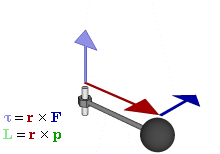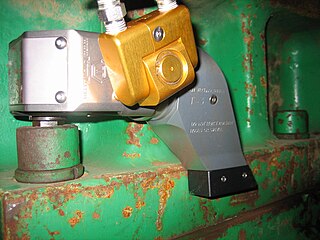 W
WIn physics and mechanics, torque is the rotational equivalent of linear force. It is also referred to as the moment, moment of force, rotational force or turning effect, depending on the field of study. The concept originated with the studies by Archimedes of the usage of levers. Just as a linear force is a push or a pull, a torque can be thought of as a twist to an object around a specific axis. Another definition of torque is the product of the magnitude of the force and the perpendicular distance of the line of action of a force from the axis of rotation. The symbol for torque is typically , the lowercase Greek letter tau. When being referred to as moment of force, it is commonly denoted by M.
 W
WA dental torque wrench or restorative torque wrench is a torque wrench used to precisely apply a specific torque to a fastener bolt for fixation of an abutment, dentures or prosthetics on a dental implant.
 W
WA hydraulic torque wrench is a power tool designed to exert torque on a fastener to achieve proper tightening or
 W
WA shear pin is a mechanical detail designed to allow a specific outcome to occur once a predetermined force is applied. It can either function as a safeguard designed to break to protect other parts, or as a conditional operator that will not allow a mechanical device to operate until the correct force is applied.
 W
WA torque converter is a type of fluid coupling which transfers rotating power from a prime mover, like an internal combustion engine, to a rotating driven load. In a vehicle with an automatic transmission, the torque converter connects the power source to the load. It is usually located between the engine's flexplate and the transmission. The equivalent location in a manual transmission would be the mechanical clutch.
 W
WIn the field of solid mechanics, torsion is the twisting of an object due to an applied torque. Torsion is expressed in either the Pascal (Pa), an SI unit for newtons per square metre, or in pounds per square inch (psi) while torque is expressed in newton metres (N·m) or foot-pound force (ft·lbf). In sections perpendicular to the torque axis, the resultant shear stress in this section is perpendicular to the radius.
 W
WA torsion spring is a spring that works by twisting its end along its axis; that is, a flexible elastic object that stores mechanical energy when it is twisted. When it is twisted, it exerts a torque in the opposite direction, proportional to the amount (angle) it is twisted. There are various types:A torsion bar is a straight bar of metal or rubber that is subjected to twisting about its axis by torque applied at its ends. A more delicate form used in sensitive instruments, called a torsion fiber consists of a fiber of silk, glass, or quartz under tension, that is twisted about its axis. A helical torsion spring, is a metal rod or wire in the shape of a helix (coil) that is subjected to twisting about the axis of the coil by sideways forces applied to its ends, twisting the coil tighter. Clocks use a spiral wound torsion spring sometimes called a "clock spring" or colloquially called a mainspring. Those types of torsion springs are also used for attic stairs, clutches, and other devices that need near constant torque for large angles or even multiple revolutions.